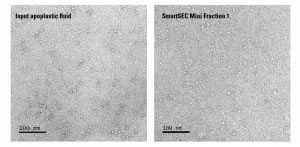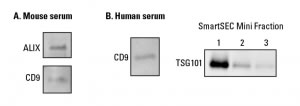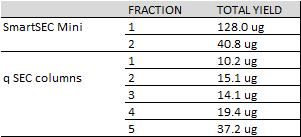SmartSEC™ Mini EV Isolation System
| Specifications | |
|---|---|
| Product Category: | Exosome Isolation |
| Sample Type: | Cell Culture Media & Biofluids |
Product Description
Isolate EVs from small volumes of biofluids from serum to Developmental Biology samples
- Powerful SmartSEC™ technology in a spin column format
- Only commercially available kit for sample volumes as low as 10 ul
- Great for isolating EVs from a range of biofluids
- Also validated for model developmental biology organisms such as Drosophila melanogaster, Planaria, Arabidopsis thaliana, Mouse and Rat
- Better purity and yield than ultracentrifugation
- Compatible with most downstream applications
SmartSEC Mini is a proprietary chromatography-based EV isolation technology that combines all the benefits of size exclusion chromatography (SEC) - purity, yield, reproducibility, and preservation of EV integrity - with a contaminant trapping feature that overcomes the limitations of conventional SEC for fast, easy, and low sample-volume EV isolation.

Table 1.SmartSEC Mini recommended input volumes
SmartSec is compatible with most downstream applications such as mass spectrometry, western blotting, nanoparticle tracking analysis (NTA), and transmission electron microscopy (TEM).
How it works
The SmartSEC Mini workflow is quick and easy (Figure 1). Simply pre-wash the SmartSEC Mini column, load your sample, incubate at room temperature for 30-minutes, and centrifuge for 30-seconds at 500 x g to recover isolated EVs. To maximize sample recovery, simply add more buffer to the column and collect up to two additional fractions.

Figure 1. SmartSEC Mini workflow.
Supporting Data
SmartSEC Mini isolates EVs from low volumes in a range of species, biofluids:

Figure 2. SmartSEC Mini provides robust isolation of EVs from Drosophila starting from 10 ul of hemolymph. Western blot analysis of 1 µg of equivalent protein (Figure 2). Common Drosophila exosome markers are shown next to molecular weight markers.Data courtesy of Dr. Karen Linnemannstöns, University of Göttingen.
SmartSEC Mini has also been used to isolate EVs from 100 ul Planaria neoblast culture media (Figure 3) and 50 ul of apoplastic fluid from Arabidopsis thaliana (Figure 4) as seen in TEM.

Figure 3. SmartSEC Mini provides robust isolation of EVs from 100 ul of Planaria neoblast culture media. Data courtesy of Dr. Vidyanand Sasidharan, Stowers Institute for Medical Research.

Figure 4. SmartSEC Mini provides robust isolation of EVs from 50 ul of apoplastic fluid from Arabidopsis thaliana. Sample courtesy of Dr. Claudia Uhde-Stone, California State University, East Bay.
SmartSEC Mini provides robust isolation of EVs from 10 ul of mouse serum (Figure 5A, Table 2) and 10 ul of human serum (Figure 5B, Table 2) as demonstrated through western blot data. In addition, SmartSEC Mini delivers more EVs than a competitor’s SEC-based EV isolation product (Table 3).

Figure 5. SmartSEC Mini delivers robust isolation of EVs from human and mouse serum.

Table 2. SmartSEC Mini delivers high yields of EVs

Table 3. SmartSEC Mini delivers more EVs than a competitor’s product
SmartSEC Mini specifically enriches for EVs versus lipoprotein particles and blood microparticles as demonstrated via mass spectrometry (Figure 6 and Table 4). The quick and easy SmartSEC Mini workflow was used to isolate EVs from 20 ul of human serum. EV-associated proteins were analyzed via mass spec. About 600 proteins were identified (see Table 4 for a representative list). A functional enrichment analysis conducted using the FunRich tool showed that over 50% of the proteins are known to be associated with exosomes whereas <30% are associated with blood microparticles and <10% are associated with lipoprotein particles (Figure 6).

Figure 6. Mass spectrometry analysis demonstrates that SmartSEC Mini preferentially isolates EVs.

Table 4. Common EV-associated proteins identified from mass spec analysis of EVs isolated with SmartSEC Mini
Product Citations
- Aly R et al. (2024) Functional and metabolomic analysis of urinary extracellular vesicles from juvenile mice with renal compensatory hypertrophy. Biochimica et Biophysica Acta (BBA) - Molecular Basis of Disease 1870.
- Avalos PN et al. (2024) Extracellular vesicles promote proliferation in an animal model of regeneration. bioRxiv
- Vikramdeo K et al. (2023) Profiling mitochondrial DNA mutations in tumors and circulating extracellular vesicles of triple-negative breast cancer patients for potential biomarker development. FASEB BioAdvances
- Zhong W et al. (2023) Upregulation of exosome secretion from tumor-associated macrophages plays a key role in the suppression of anti-tumor immunity. Cell Rep 42 (10).
- Catalog Number
SSEC100A-1-SBI - Supplier
SBI System Biosciences - Size
- Shipping
RT

